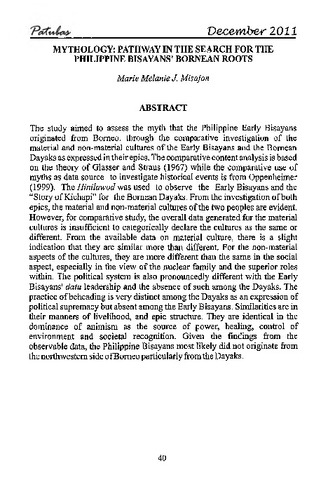Mythology: Pathway in the search for the Philippine Bisayans’ Bornean roots
| dc.contributor.author | Javier, Marie Melanie J. | |
| dc.coverage.spatial | Borneo | en_US |
| dc.coverage.spatial | Visayas | en_US |
| dc.coverage.spatial | Southeast Asia | en_US |
| dc.date.accessioned | 2021-03-22T06:05:11Z | |
| dc.date.available | 2021-03-22T06:05:11Z | |
| dc.date.issued | 2011-12 | |
| dc.identifier.citation | Misajon, M. M. J. (2011). Mythology: Pathway in the search for the Philippine Bisayans’ Bornean roots. Patubas, 6(1), 40-51. | en_US |
| dc.identifier.issn | 1908-515X | |
| dc.identifier.uri | https://hdl.handle.net/20.500.12852/635 | |
| dc.description | Journal article | en_US |
| dc.description.abstract | The study aimed to assess the myth that the Philippine Early Bisayans originated from Borneo, through the comparative investigation of the material and non-material cultures of the Early Bisayans and the Bornean Dayaks as expressed in their epics. The comparative content analysis is based on the theory of Glasser and Straus (1967) while the comparative use of myths as data source to investigate historical events is from Oppenheimer (1999). The Hinilawod was used to observe the Early Bisayans and the “Story of Kichapi” for the Bornean Dayaks. From the investigation of both epics, the material and non-material cultures of the two peoples are evident. However, for comparative study, the overall data generated for the material cultures is insufficient to categorically declare the cultures as the same or different. From the available data on material culture, there is a slight indication that they are similar more than different. For the non-material aspects of the cultures, they are more different than the same in the social aspect, especially in the view of the nuclear family and the superior roles within. The political system is also pronouncedly different with the Early Bisayans' datu leadership and the absence of such among the Dayaks. The practice of beheading is very distinct among the Dayaks as an expression of political supremacy but absent among the Early Bisayans. Similarities are in their manners of livelihood, and epic structure. They are identical in the dominance of animism as the source of power, healing, control of environment and societal recognition. Given the findings from the observable data, the Philippine Bisayans most likely did not originate from the northwestern side of Borneo particularly from the Dayaks. | en_US |
| dc.language.iso | en | en_US |
| dc.publisher | Central Philippine University | en_US |
| dc.rights | Attribution-NonCommercial-NoDerivs 3.0 Philippines | * |
| dc.rights.uri | http://creativecommons.org/licenses/by-nc-nd/3.0/ph/ | * |
| dc.subject.lcsh | Dayak (Bornean people) | en_US |
| dc.subject.lcsh | Philippines--Visayan Islands | en_US |
| dc.subject.lcsh | Borneo | en_US |
| dc.subject.lcsh | Mythology | en_US |
| dc.subject.lcsh | Culture | en_US |
| dc.subject.lcsh | Ethnology | en_US |
| dc.subject.lcsh | Philippines--Western Visayas | en_US |
| dc.subject.lcsh | Comparative studies | en_US |
| dc.subject.lcsh | Mythology--Comparative studies | en_US |
| dc.subject.lcsh | Cross-cultural studies | en_US |
| dc.subject.lcsh | Southeast Asia | en_US |
| dc.title | Mythology: Pathway in the search for the Philippine Bisayans’ Bornean roots | en_US |
| dc.type | Article | en_US |
| dc.citation.firstpage | 40 | en_US |
| dc.citation.lastpage | 51 | en_US |
| dc.citation.journaltitle | Patubas | en_US |
| dc.citation.volume | 6 | en_US |
| dc.citation.issue | 1 | en_US |
| local.subject | Visayans | en_US |
| local.subject | Hinilawod | en_US |
| local.subject | Ethnography | en_US |
Fichier(s) constituant ce document
Ce document figure dans la(les) collection(s) suivante(s)
-
Journal articles [36]
-
Patubas [110]
Patubas is a refereed research journal of Central Philippine University.



